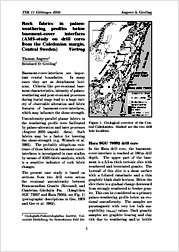Rock fabrics in palaeoweathering profiles below basement-cover interfaces (AMS-study on drill cores from the Caledonian margin, Central Sweden)
Angerer, Thomas
Greiling, Reinhard O.
Universitätsverlag Göttingen
Sammelband- / Konferenzbeitrag
Verlagsversion
Deutsch
Angerer, Thomas; Greiling, Reinhard O., 2006: Rock fabrics in palaeoweathering profiles below basement-cover interfaces (AMS-study on drill cores from the Caledonian margin, Central Sweden). In: Philipp, S., Leiss, B, Vollbrecht, A., Tanner, D. & Gudmundsson, A. (eds.): 11. Symposium "Tektonik, Struktur- und Kristallingeologie" - Univ.-Verl. Göttingen, 2006, S. 9 - 12., , DOI: 10.23689/fidgeo-1925.
 |
Dokument öffnen: |
Basement-cover-interfaces are important
crustal boundaries. In many
cases they act as detachment horizons.
Criteria like pre-erosional basement
characteristics, intensity of palaeoweathering
and post-erosional processes
during burial stage lead to a huge variety
of observable alteration and fabric
features of basement-cover-interfaces,
which may influence the shear-strength.
Unconformity-parallel planar fabrics in
the weathering profile were facilitated
by palaeo-alteration and later processes
(Angerer 2005 unpubl. data). Such
fabrics may be a factor for lowering
the shear-strength (e.g. Wintsch et al.
1995). The probably ubiquitous existence
of those fabrics at basement-coverinterfaces
is investigated in case studies
by means of AMS-fabric analysis, which
is a sensitive indicator of rock fabric
changes.
The present case study is based on
sections from two drill cores across
the erosional unconformity between
Fennoscandian Granite (Revsund) and
Cambrian Gärdsjön Fm. (Långviken
SGU 73007 and Hara 79002)
(petrographic descriptions in Gee, 1978
and Gee et al. 1982).

